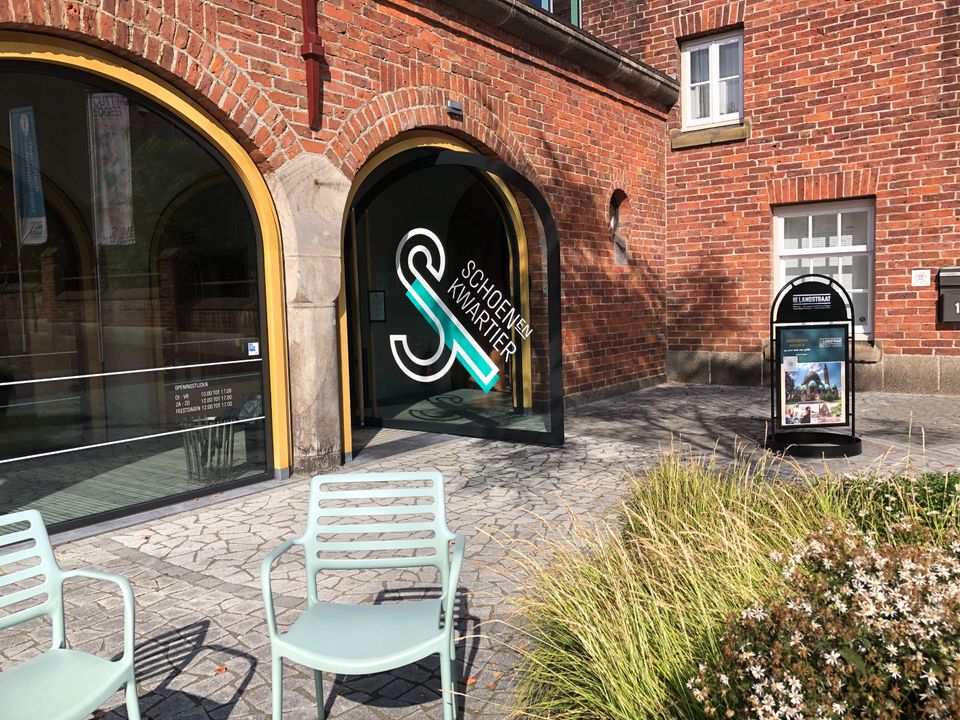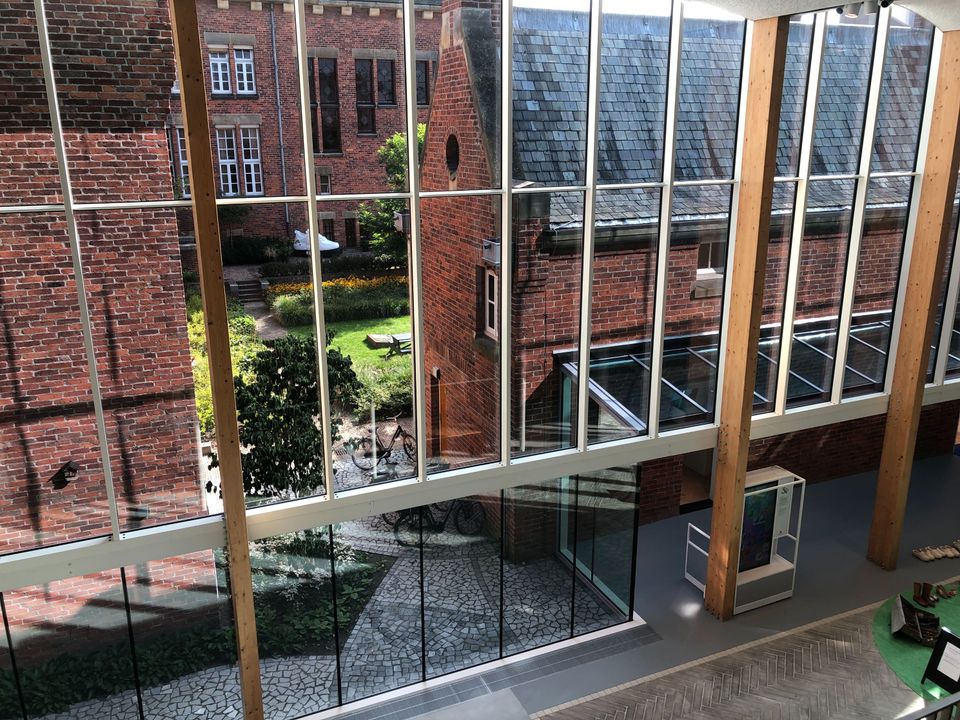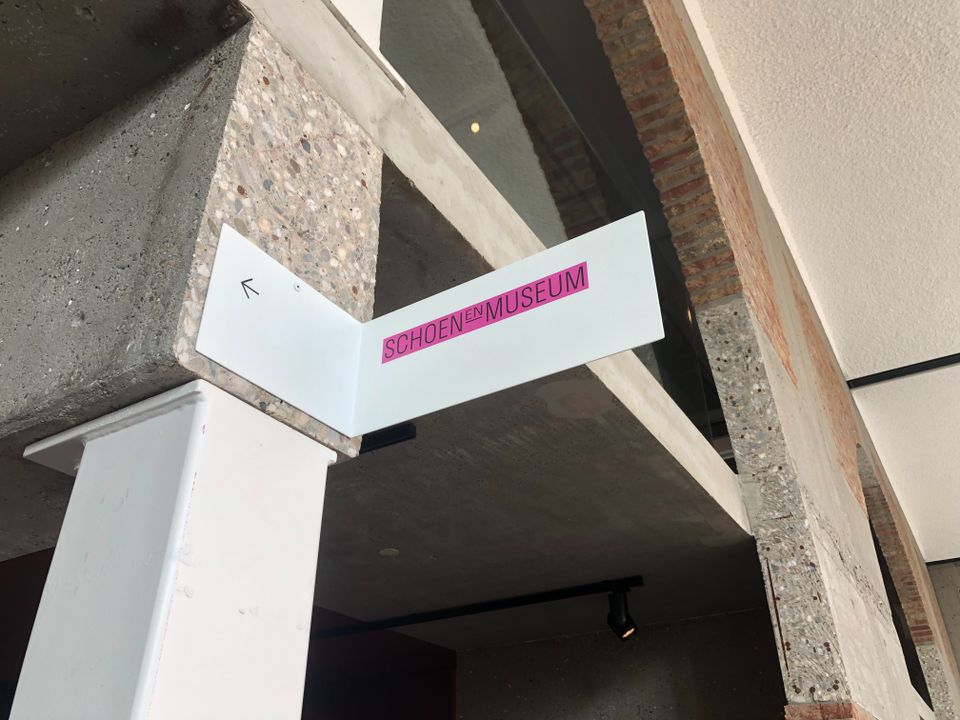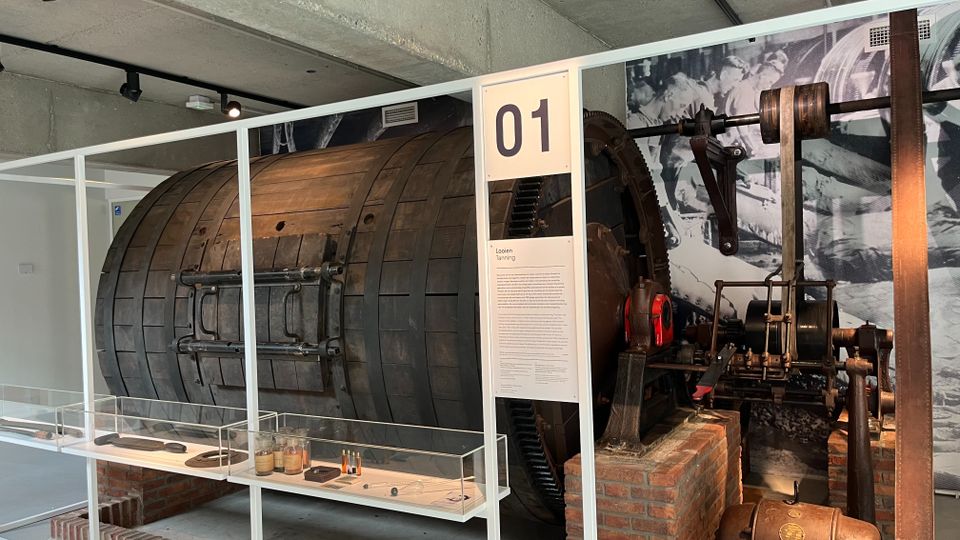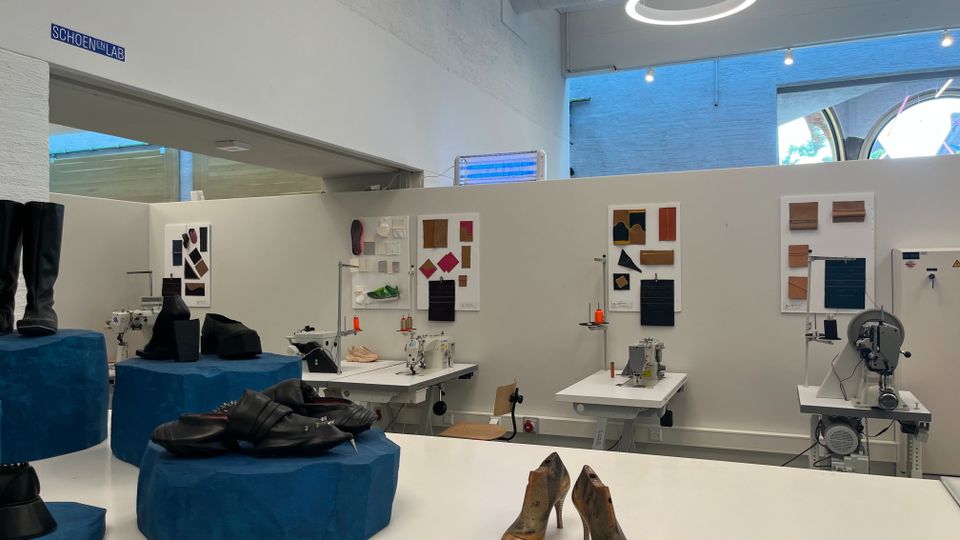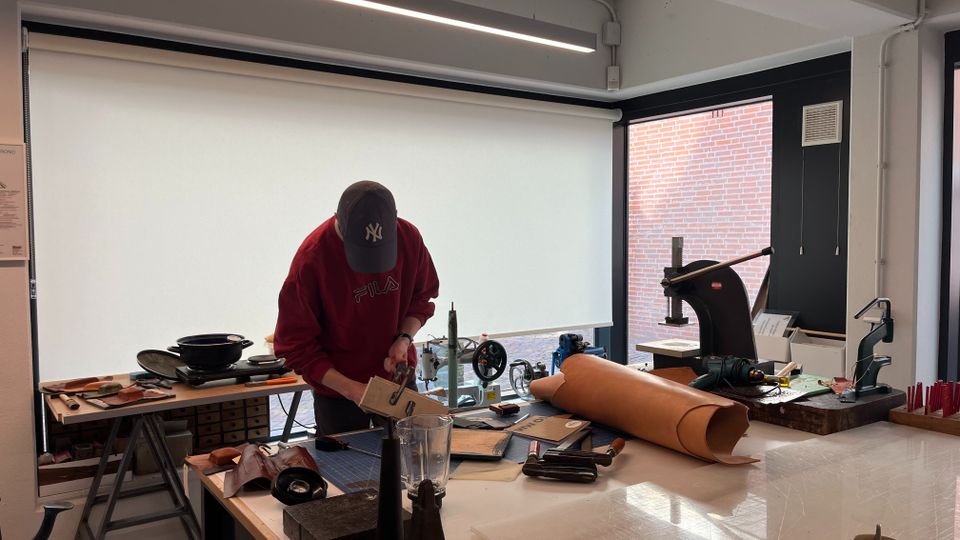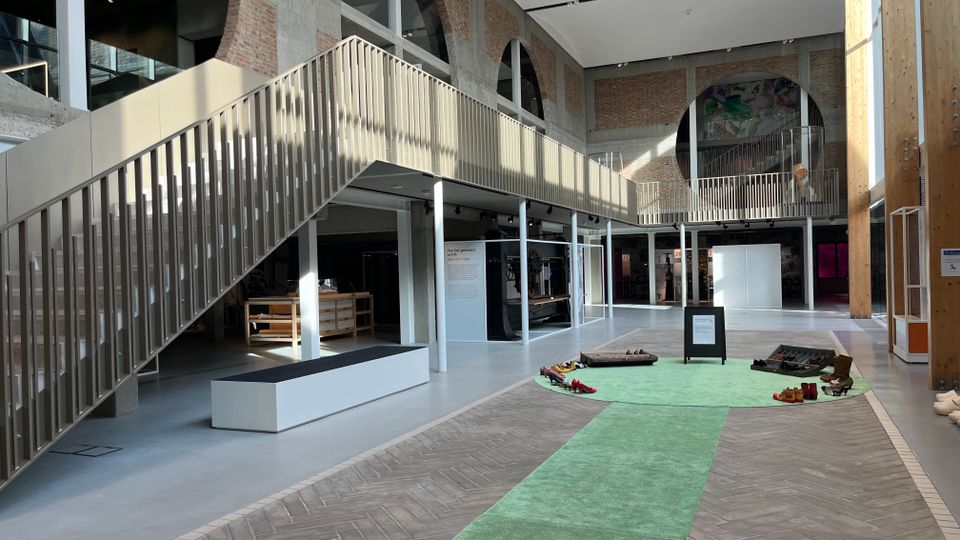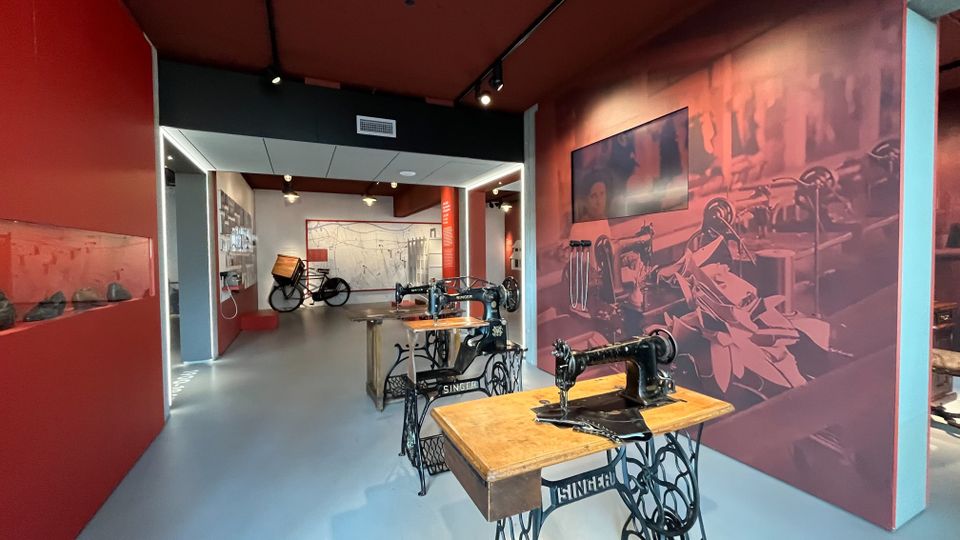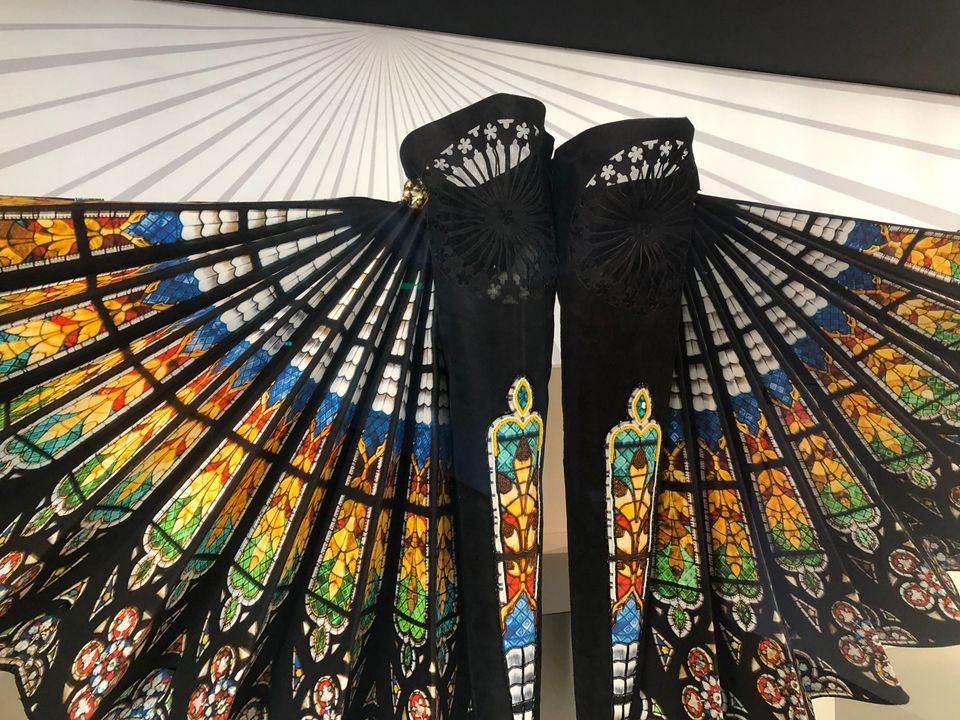Pearl of De Langstraat: Schoenenkwartier
The shoe museum in Waalwijk is back! And in what a place. The west wing of the national monumental Kropholler complex in the heart of Langstraat is the new home of the shoe museum. A new place also came with a new name: The Schoenenkwartier.
After a short walk, I arrive at Council House Square where the Schoenenkwartier is located. On the square I am welcomed by the tinkling of the Council House bells and the splashing water of the fountain. Looking around me at the imposing Kropholler complex, I walk into the entrance to Schoenenkwartier. The friendly lady behind the counter welcomes me. I tell her that I have come to see Toontje Smink, with whom I have an interview today.
Toontje is already arriving, and we shake hands. ''Have a seat, what do you want to drink?" she asks. To her, of course, this is all very normal, but I have to look around myself a bit. In the middle of the large hall is a long bar with the store on the right and the café on the other side. There we take our seats together.
The building made quite an impression on me, so I ask Toontje to tell me a little more about it. ''We are here in the Kropholler complex,'' she says. ''It was built in 1931-1932 by renowned architect Alexander Kropholler and is known for its hot red facade bricks, all of which are hand-formed.'' The building attracts much attention from (inter)national architects. ''Look, there's another one of those groups,'' notes Toontje as we're talking about it. Indeed, in the entrance hall I see a group of men checking out the ceiling. You wouldn't expect it for a building nearly 100 years old, but it's also super modern. That's in the climate friendliness. Toontje explains that there are a large number of solar panels on the roof, there is a heat pump and sustainable building materials have been used. This is evidenced by the long bar made of the sustainable material hemp concrete.
Years ago, the shoe museum was in a different location in Waalwijk. There it revolved around the production of the shoe, now the new museum has taken a different path. At Schoenenkwartier, in addition to the rich past of the leather and shoe industry, it is more about the future of the shoe. Thus, the museum also serves as a workshop, study center and laboratory to give space to innovation. ''We collaborate with various educational institutions, shoe designers and artists'' , says Toontje, ''these groups can use our professional Making Lab''. It's a great addition to the visitor's experience because you can see the makers at work with your own eyes. Now, as a visitor, you certainly don't have to just watch either. ''We also offer all kinds of workshops from 'bag making' to 'sneaker mosaics'. These are low-threshold workshops and can be combined with a museum visit,'' says Toontje. The website makes it easy to sign up for the workshops.
In the café we are chatting about Schoenenkwartier. But actually I am eager to start the tour Toontje has promised me. Today she is an occasional guide, normally she likes to leave this to the real guides. ''I've already gained a lot of knowledge in the short time I've been working it, but for all the details you really need to book a guide,'' she says. ''I find out that there are quite a few themed tours to book. So you have a general tour, but also on different themes: architecture, history and technology. Of which the last two are done by guides with a past in the leather and shoe industry who tell you all kinds of stories about the old days in all sorts of ways.
The last sip of my coffee also marks the beginning of our tour of the museum. After a few steps away from the table, we walk into a workshop. The building is not very busy, so I am surprised to see two people working here. On either side are a bunch of machines, what they are being used for, no idea. One of the two in the workshop stands behind a pan. Why is he standing here cooking an egg, I thought to myself, but my assumption turns out to be wrong. It turns out to be Daan, a student working here with the cuir bouilli leather working technique. In the pan, he is not cooking eggs, but leather. This technique involves heating the leather, turning the flexible leather into a very hard and water-repellent material. ''Here, you should feel it,'' Toontje says. ''Well, it is indeed rock hard. This technique was transmitted by word of mouth and dates back to the late Middle Ages and has been given a second life today. It was used, for example, in the movie Wonder Woman and in the hit series Game of Thrones. And from October 7, 2023 to March 31, 2024, the Schoenenkwartier is dedicated to this leatherworking technique with the exhibition: The Magic of Cuir Bouilli: From Armor to Haute Couture .
From the cuir bouilli we walk to the machines of days gone by. We imagine ourselves in a factory. The process is told here from beginning to end by the machines. It starts with the machines to tan the leather. ''Some of the machines even work,'' Toontje says. ''I can't do this myself, but the guides do that during the tours''. From the leather-tanning process, we arrive at the making of the shoe. ''Do you know how many parts a shoe consists of?'' Toontje asks me. I have no idea. She shows a screen where you can zoom in and out. So first you see the shoe and when you zoom out you see the shoe with all its parts. Insane. A shoe is so obvious nowadays, you don't realize the process behind it. In the Schoenenkwartier you do become aware of that. ''It does consist of more than 220 parts,'' I hear from Toontje. I am impressed by the number of machines used in those days to produce a shoe. Then we come to a whipping machine. The, at first glance seemingly normal, machine turns out to have been a revolutionary invention. ''The invention of the zipper machine enabled the production of 50 shoes to be increased to 350 pairs of shoes. And that in the same time frame," Toontje says. To this day, this device, which comes from the late 19th century, is still in use. We continue our walk through the process of the shoe until we arrive at the heel. ''This is the last part of the shoe,'' Toontje says. ''Now we go up one floor, where 'the story of De Langstraat' is told.''
The long corridor through which we walk is a time machine. The history of the Langstraat, which from about 1850 was the center of the leather and shoe industry, is shown in different time periods. We arrive in the 1850-1900 era titled "The Langstraat on Steam," and the next one is called "High Hats - Flat Hats. But what impresses me most is the recreated shoe store with its vintage billboards of such diverse brands as Swift, Vredestein and Bata. On one of the signs I read, ''Swift - the shoe for every season.'' It was one of the last rooms before this "time machine" brings us back to the present. After a tour of the Knowledge Center, which consists of a library and auditorium, we walk up the stairs to the second floor.
We pass right after the stairs the"Cutting Edges" exhibition, which will give way to the exhibition oncuir bouilli after this week. The exhibitions succeed each other, keeping the museum dynamic. After looking around here for a while, we make our way to the permanent exhibition where shoe and identity are linked. We enter a room with dimmed light - otherwise the light affects the shoes too much - with exhibited shoes in display cases on which, for example, rituals, sports and work are written. In one of the showcases I see not only contraband shoes but also crocs , which - what I learned there - are commonly worn by hospital workers. The dimmed light gives way to a stark white space. That's just as well, because here are shoes that should be seen. Here are the really fancy designer shoes, they are shoes that have been used on the catwalk. There is everything from shoes with spikes to a boot with wings. You can think of anything. ''Look, here you have a movie,'' Toontje says. Together we stand chuckling as models with impossible shoes stumble onto the catwalk. And the funny thing about that movie is that some of the shoes are displayed in the museum. I stand looking at the showcases with admiration. But for me it is only watching, because I would not put on such a shoe myself.
We descend again to the entrance hall where we say hello to each other. ''Take a look around some more if you like,'' Toontje says. I will certainly take advantage of that offer for a while. I thank Toontje for the pleasant and informative conversation and dive into the museum a little more!
Did you know...
...3D printing is also used in the "Make Lab" to produce the last of the shoe?
...recently featured the Schoenenkwartier on the TV program"Now to be seen"?
...there is also a store at Schoenenkwartier with a wide range of leather and shoe care items, books and gift items?
...the Schoenenkwartier has a fun interactive scavenger hunt for children?
Click here for more information about the Schoenenkwartier.
